New Found Intersects 21.12 g/t Au over 7.20m, 79.81 g/t Au over 3.00m & 119.45 g/t over 2.40m at Keats Zone & Identifies New High-Grade Near Surface Mineralization
Vancouver, BC, April 11, 2022 – New Found Gold Corp. (“New Found” or the “Company”) (TSX-V: NFG, NYSE-A: NFGC) is pleased to announce assay results from 45 diamond drill holes designed to expand the high-grade gold mineralization at the Keats discovery located within a 9.45km segment of the +100km regional-scale Appleton Fault Zone (‘AFZ’) on the northern portion of Queensway project that New Found is targeting with a 400,000m drill campaign. The Queensway project comprises an approximately +1500km2 area with initial exploration focus in areas accessed via the Trans-Canada Highway approximately 15km west of Gander, Newfoundland.
Keats Highlights

- Reconnaissance drilling designed to test a possible southern extension of the Keats Main Zone intersected gold mineralization near surface including 4.49 g/t Au over 3.55m and 7.85 g/t Au over 4.85m in NFGC-21-421. This new discovery has been named the “421 Zone”. Step-out drilling from these initial holes returned intervals of 4.31 g/t Au over 2.25m and 2.58 g/t Au over 10.40m in NFGC-21-467 confirming that this fault zone dips southwest at approximately 50° and is host to high-grade gold. Drilling will continue to step-out on this structure and importantly, will also target its intersection along strike with the Keats Main Zone and the AFZ (Figures 1, 2, and 3).
- Drilling into the footwall area located between the AFZ and the Keats-Baseline Fault continues to identify new veins and associated structures that contain high-grade gold, and this is well demonstrated by intercepts 119.45 g/t Au over 2.40m in NFGC-21-375 and 6.66 g/t Au over 5.90m in NFGC-21-342. The gold mineralization is hosted within a vein breccia and stockwork domain that trends approximately parallel to and is within the immediate footwall of the AFZ and appears to be spatially associated with the contact of a greywacke unit (Figures 3 and 7).
- Significant high-grade gold mineralization identified in a region previously interpreted to form the hanging wall to the Keats-Baseline Fault Zone produces an important exploration target and also further advances the structural understanding of the Keats Zone. Highlight intercepts of 9.35 g/t Au over 2.70m in NFGC-21-254 and 7.21 g/t Au over 5.75m in NFGC-21-392 occur within two distinct structures that are adjacent to and crosscut the Keats Main Zone and are interpreted to be constituents of the broader damage zone associated with the Keats-Baseline Fault and appear to control domains of high-grade gold mineralization (Figures 3 and 7).
- At the north end of Keats, recent drilling intersected a significant vein grading 79.81 g/t Au over 3.00m in NFGC-22-491 approximately 52m down-dip of NFGC-21-90 which previously reported 24.50 g/t Au over 3.85m (see March 16, 2021, news release). Follow-up drilling is underway to expand on this discovery (Figures 1, 2, 3 and 5).
- A massive interval of brecciated, stylolitic and stockwork vein phases occurring within the dilational core of the Keats-Baseline Fault Zone was intersected by NFGC-21-464 and contained a grade of 21.12 g/t Au over 7.20m. The characteristics of this zone demonstrate that the south-west plunging, thickened and continuous domain of high-grade gold exists within a portion of the Keats Baseline Fault Zone that experienced significant volumes of gold mineralizing fluid flow. The intercept of 62.30 g/t Au over 2.00m in NFGC-21-387 (see February 24, 2022, news release) has traced this corridor over a length of 845m in a down-plunge direction. Exploration is currently working to expand this domain south (Figures 2, 3 and 6).
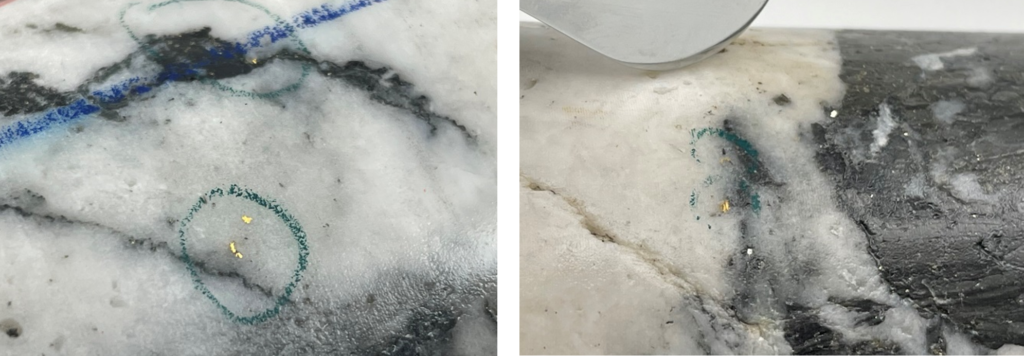
Right: Photo of mineralization from NFGC-21-421at approximately 21m down hole depth
1Note that these photos are not intended to be representative of gold mineralization in hole NFGC-22-491 and NFGC-21-421
Melissa Render, P.Geo., VP Exploration for New Found, stated: “Significant model advancements have been made recently following the addition of a senior geologist to our New Found exploration team, with wizardry 3D-modelling skills that have greatly increased our understanding of the Keats Zone. This work has identified a multitude of high-priority target areas that will be the focus of upcoming drilling. The strength of the mineralizing system along the Keats-Baseline Fault Zone is exceptional based on the extensive amount of veining, alteration, brittle deformation and high-grade gold mineralization. Drills are working aggressively to continue to extend the Keats Main high-grade domain down plunge which now extends a length of approximately 845m. Drills are also turning to test for new structures and high-grade intersections like the 421 Zone in addition to the very underexplored west side of the AFZ that is also known to host high-grade gold mineralization. As noted previously, other orogenic deposit analogues with mineralizing systems adjacent to these deep crustal-scale structures such as the AFZ can extend to depths of +2km. Our drilling to date has focused above 300m vertical depth, with the deepest high-grade intercept to date at approximately 375m. Exploration along this 9.45 km segment of the +100km strike of the AFZ that New Found controls continues to build the evidence that a camp is emerging (Figure 4).”
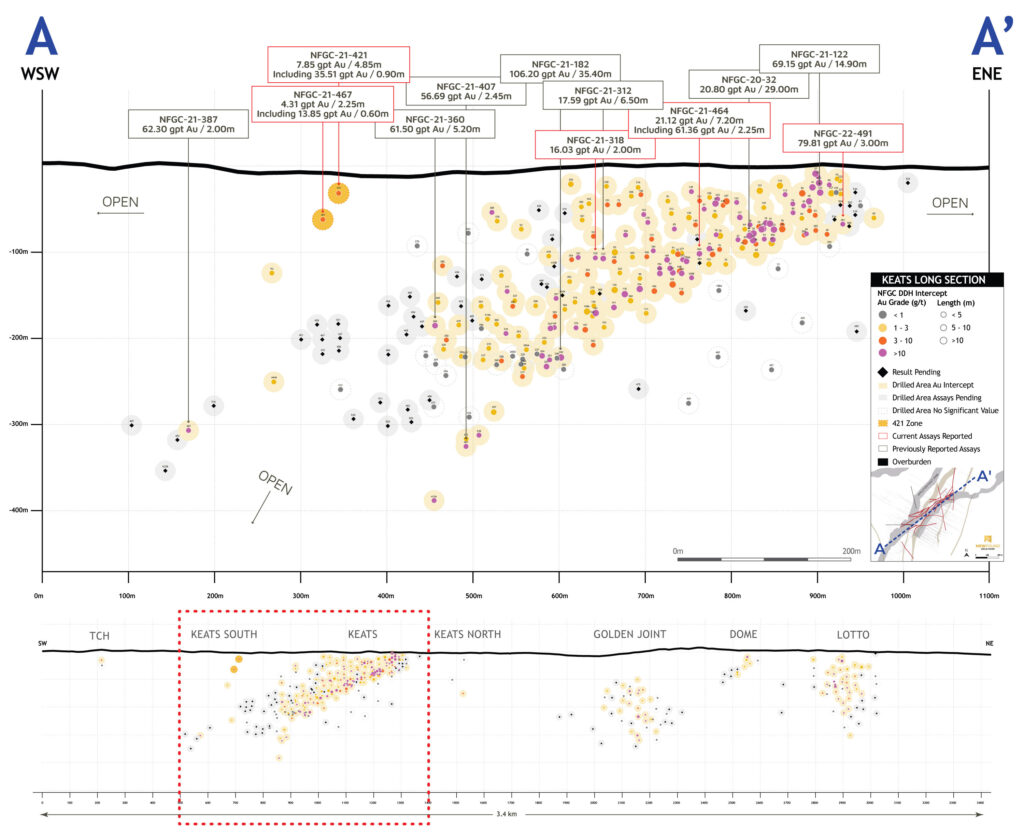
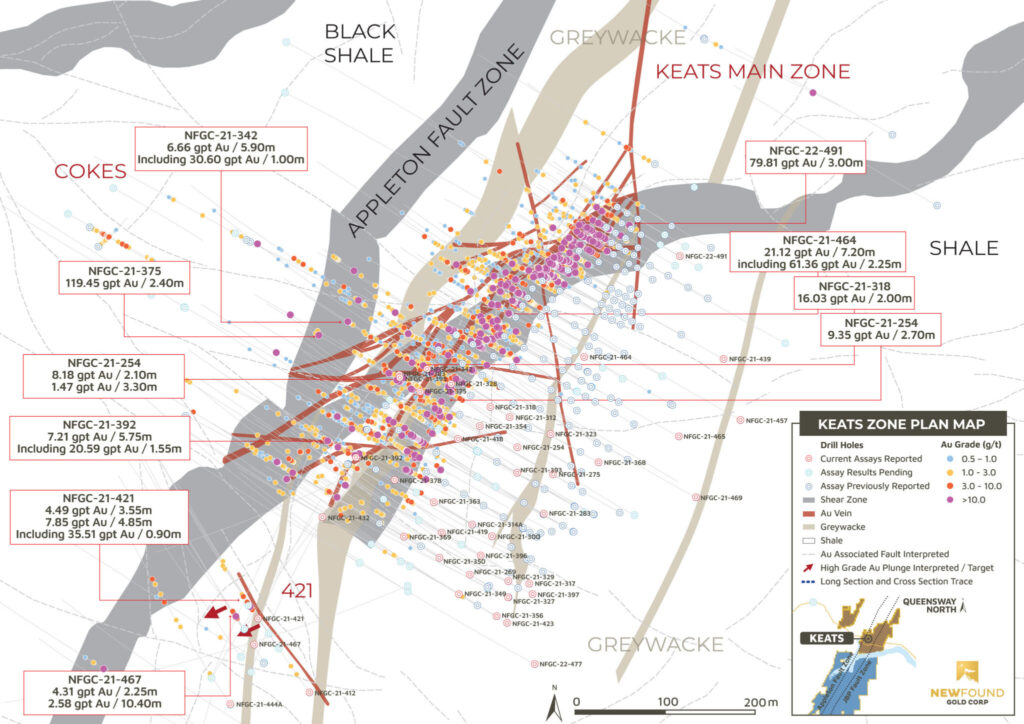
Discussion
Mineralization at the Queensway Project is hosted by a fold-thrust sequence of northeast-striking, steeply dipping turbiditic sedimentary rocks deposited and deformed during the closure of the Iapetus Ocean and subsequent continent-continent collision. During this prolonged period of continued shortening, at least two regional-deformation zones developed and include the Appleton and JBP fault zones. The AFZ is interpreted to be a significant, deep-seated thrust fault, that strikes southwest across the full 100km+ length of the property and is likely the main conduit for the gold mineralizing fluids, much like the Cadillac-Larder Lake Fault Zone in the Abitibi.
As a result of progressive deformation, the brittle host stratigraphy developed an extensive network of gold-bearing fault zones enveloping the AFZ, the extents of which are not yet known. This structural relationship is well illustrated in Figure 4 and demonstrates the currently defined vein and associated fault orientations based on structural interpretation and drilling to date along the 2.6km corridor from Keats to Lotto. Higher-grades and widths of gold mineralization occur in areas where there was greater mineralizing fluid flow such as at structural intersections, at dilational openings within fault structures, and along lithological contacts where breakage occurs due to rheological differences in the compressional strength of contrasting sedimentary rock units.
The Company’s current interpretation is that the high-grade gold mineralization being drilled at Queensway was deposited by gold mineralizing fluids penetrating this highly fractured and deformed meta-sedimentary sequence forming an extensive mineralized corridor surrounding the deep crustal-scale fault network that forms the Appleton Fault Zone. A significant amount of the high-grade gold mineralization is interpreted to be epizonal in nature, having been emplaced when tectonic movements resulted in the explosive tapping of deep gold-rich magmatic fluids that rapidly precipitated gold as they migrated towards surface.
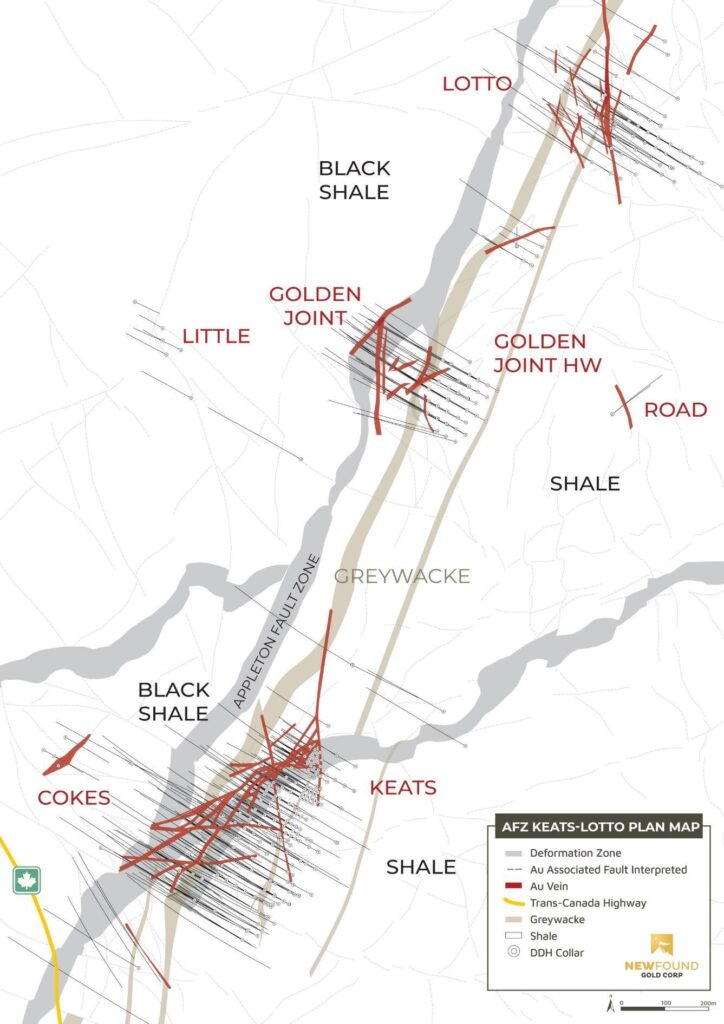
Keats
Mineralization at Keats is associated with a significant east-northeast striking and moderately southeast dipping brittle fault zone that developed adjacent to and trends at an oblique angle to the AFZ. Situated approximately 1.8km south of Lotto and 1.2km south of the Golden Joint discoveries, this fault forms an extensive damage zone that is discordant to the northeast striking and steeply dipping stratigraphy and controls the development of a complex network of high-grade gold vein arrays that are epizonal in character and exhibit breccia, stylolitic, and vuggy textures. The host rock units are comprised of an interbedded sequence of turbiditic shales and greywackes where lithological contrasts in part control domains of high-grade gold, however model advancements suggest the larger underlying control are dilational settings that experienced increased fluid flow that typically develop at structural intersections such as intersecting fault or vein segments. The Keats-Baseline Fault Zone expresses itself as a topographic low and interpretation of this low has traced it over approximately +2km strike length. At this stage, exploration has been largely focused within close proximity to the AFZ and has delineated a high-grade gold segment of the Keats-Baseline Fault over a strike length of approximately 660m, the high-grade southwest plunging dilational zone to approximately 845m while the deepest high-grade gold intercept to date is at a vertical depth of 375m.
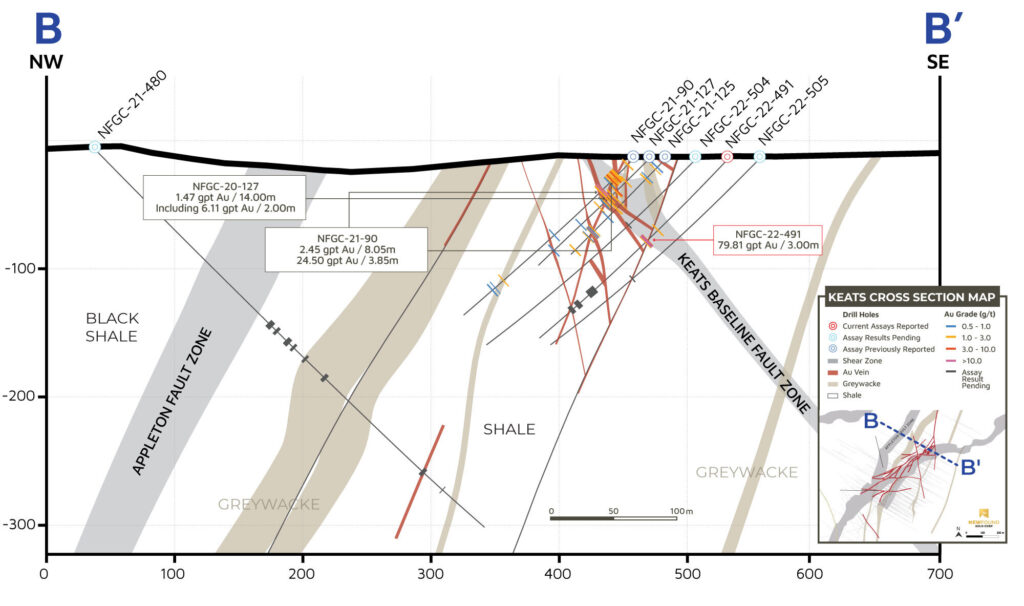
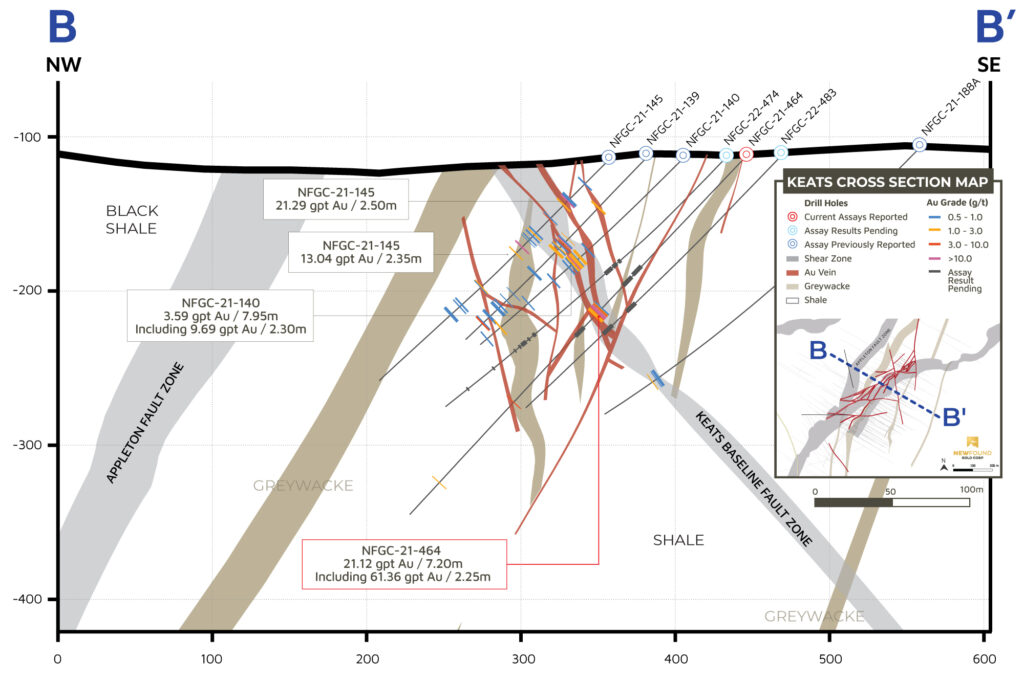
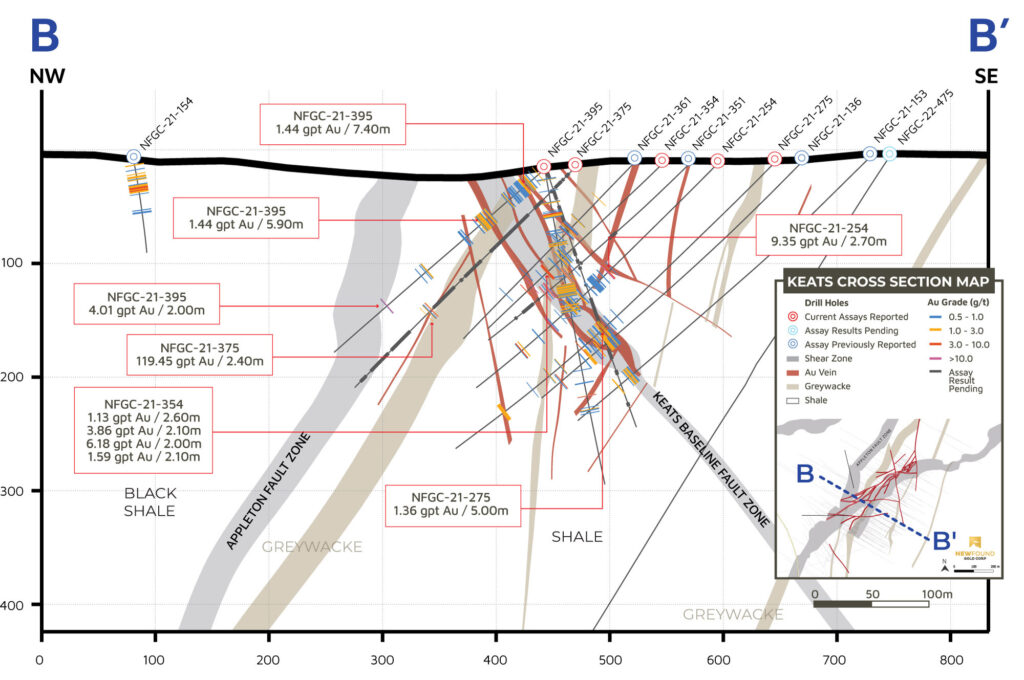
Drillhole Details

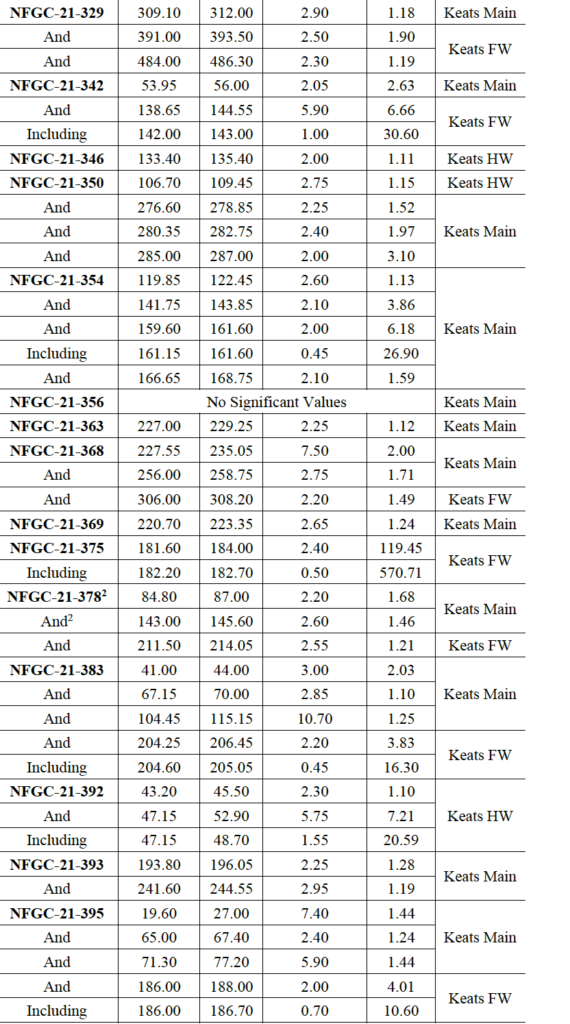
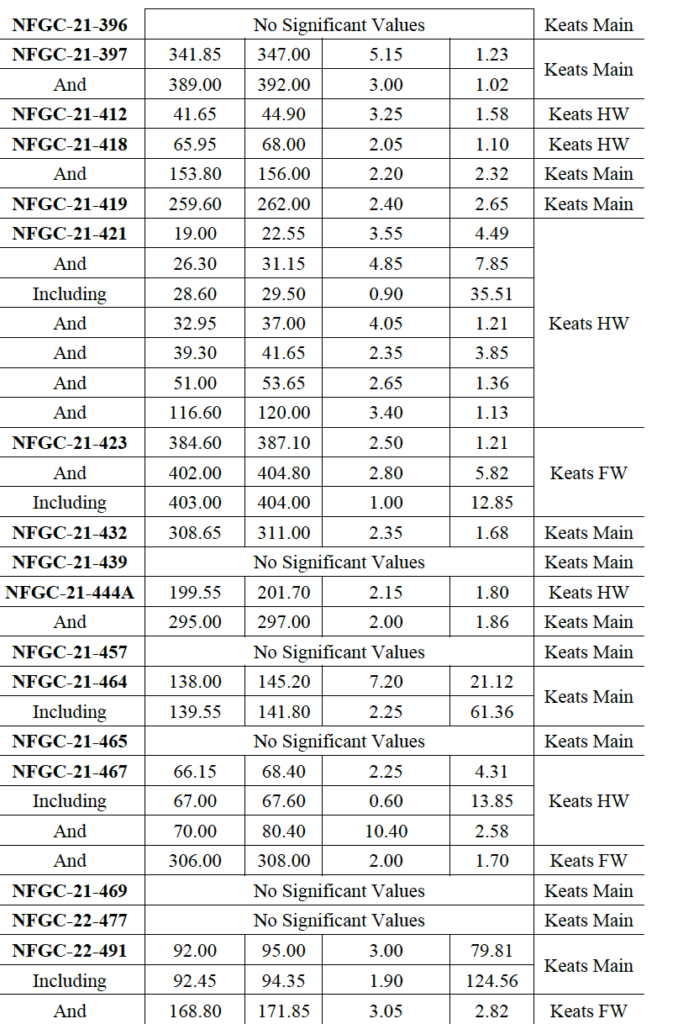
1Note that the host structures are interpreted to be steeply dipping and true widths are generally estimated to be 60% to 95% of reported intervals. Infill veining in secondary structures with multiple orientations crosscutting the primary host structures are commonly observed in drill core which could result in additional uncertainty in true width. Composite intervals reported carry a minimum weighted average of 1 g/t Au diluted over a minimum core length of 2m with a maximum of 2m consecutive dilution. Included high-grade intercepts are reported as any consecutive interval with grades greater than 10 g/t Au. Grades have not been capped in the averaging and intervals are reported as drill thickness.2Composite intervals previously reported.
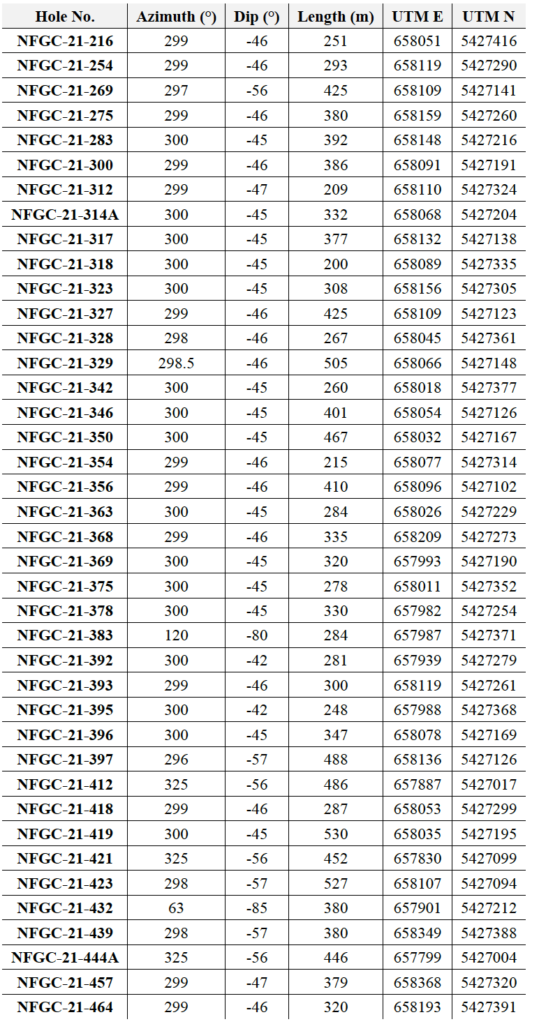

Queensway 400,000m Drill Program Update
Approximately 40% of the planned 400,000m program at Queensway has been drilled to date with approximately 19,120m of the core with pending assay results. Eleven core rigs are currently operating and New Found is targeting an increase in the drill count to 14 rigs.
Sampling, Sub-sampling, Laboratory and Discussion
True widths of the intercepts reported in this press release have yet to be determined but are estimated to be 60% to 95% of reported core lengths. Infill veining in secondary structures with multiple orientations crosscutting the primary host structures are commonly observed in drill core which could result in additional variability in true width. Assays are uncut, and composite intervals are calculated using a minimum weighted average of 1 g/t Au diluted over a minimum core length of 2m with a maximum of 2m consecutive dilution. Included high-grade intercepts are reported as any consecutive interval with grades greater than 10 g/t Au. All HQ split core assays reported were obtained by either complete sample metallic screen/fire assay or standard 30-gram fire-assaying with ICP finish at ALS Minerals in Vancouver, British Columbia, or by entire sample screened metallic screen fire assay at Eastern Analytical in Springdale, Newfoundland, except for drill hole NFGC-21-421 where whole core samples were submitted to Intertek Australia Perth for Chrysos PhotonAssayTM method as part of a test program; all three laboratories operate under a commercial contract with New Found. A selection of Chrysos PhotoAssayTM method samples are currently being assayed to extinction using traditional fire assay method for QC purposes, the results of this work will be reported once available. The complete sample metallic screen assay method is selected by the geologist when samples contain coarse gold or any samples displaying gold initial fire assay values greater than 1.0 g/t Au. Drill program design, Quality Assurance/Quality Control and interpretation of results is performed by qualified persons employing a Quality Assurance/Quality Control program consistent with industry best practices. Standards and blanks are included with every 20 samples for Quality Assurance/Quality Control purposes by the Company as well as the lab. Approximately 3% of sample pulps are sent to secondary laboratories for check assays. The company does not recognize any factors of drilling, sampling or recovery that could materially affect the accuracy or reliability of the assay data disclosed. The assay data disclosed in this news release has been verified by the Company’s Qualified Person against the original assay certificates. The Company notes that it has not completed any economic evaluations of its Queensway Project and that the Queensway Project does not have any resources or reserves.
Qualified Person
The technical content disclosed in this press release was reviewed and approved by Greg Matheson, P. Geo., Chief Operating Officer, and a Qualified Person as defined under National Instrument 43-101. Mr. Matheson consents to the publication of this news release dated April 11, 2022, by New Found. Mr. Matheson certifies that this news release fairly and accurately represents the information for which he is responsible.
About New Found Gold Corp.
New Found holds a 100% interest in the Queensway Project, located 15km west of Gander, Newfoundland, and just 18km from Gander International Airport. The project is intersected by the Trans-Canada Highway and has logging roads crosscutting the project, high voltage electric power lines running through the project area, and easy access to a highly skilled workforce. The Company is currently undertaking a 400,000m drill program at Queensway, now approximately 40% complete. The Company is well funded for this program with a current working capital balance of approximately $106 million.
Please see the Company’s website at www.newfoundgold.ca and the Company’s SEDAR profile at www.sedar.com.
Acknowledgements
New Found acknowledges the financial support of the Junior Exploration Assistance Program, Department of Natural Resources, Government of Newfoundland and Labrador.
Contact
To contact the Company, please visit the Company’s website, www.newfoundgold.ca and make your request through our investor inquiry form. Our management has a pledge to be in touch with any investor inquiries within 24 hours.
New Found Gold Corp.
Per: “Craig Roberts”
Craig Roberts, P.Eng., Chief Executive Officer
Email: croberts@newfoundgold.ca
Phone: +1 (845) 535-1486
Neither the TSX Venture Exchange nor its Regulation Services Provider (as that term is defined in the policies of the TSX Venture Exchange) accepts responsibility for the adequacy or accuracy of this release.
Forward-Looking Statement Cautions
This press release contains certain “forward-looking statements” within the meaning of Canadian securities legislation, relating to assay results, exploration and drilling on the Company’s Queensway gold project in Newfoundland, interpretation of the assay results and the results of the drilling program, the discovery of zones of high-grade gold mineralization, follow-up step-out drilling and funding of the drilling program. Although the Company believes that such statements are reasonable, it can give no assurance that such expectations will prove to be correct. Forward-looking statements are statements that are not historical facts; they are generally, but not always, identified by the words “expects,” “plans,” “anticipates,” “believes,” “intends,” “estimates,” “projects,” “aims,” “suggests,” “potential,” “goal,” “objective,” “prospective,” “possibly,” and similar expressions, or that events or conditions “will,” “would,” “may,” “can,” “could” or “should” occur, or are those statements, which, by their nature, refer to future events. The Company cautions that forward-looking statements are based on the beliefs, estimates and opinions of the Company’s management on the date the statements are made, and they involve a number of risks and uncertainties. Consequently, there can be no assurances that such statements will prove to be accurate and actual results and future events could differ materially from those anticipated in such statements. Except to the extent required by applicable securities laws and the policies of the TSX Venture Exchange, the Company undertakes no obligation to update these forward-looking statements if management’s beliefs, estimates or opinions, or other factors, should change. Factors that could cause future results to differ materially from those anticipated in these forward-looking statements include risks associated with possible accidents and other risks associated with mineral exploration operations, the risk that the Company will encounter unanticipated geological factors, risks associated with the interpretation of assay results and the drilling program, the possibility that the Company may not be able to secure permitting and other governmental clearances necessary to carry out the Company’s exploration plans, the risk that the Company will not be able to raise sufficient funds to carry out its business plans, and the risk of political uncertainties and regulatory or legal changes that might interfere with the Company’s business and prospects. The reader is urged to refer to the Company’s Annual Information Form and Management’s discussion and Analysis, publicly available through the Canadian Securities Administrators’ System for Electronic Document Analysis and Retrieval (SEDAR) at www.sedar.com for a more complete discussion of such risk factors and their potential effects.